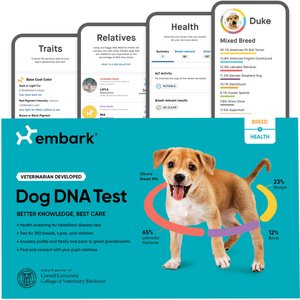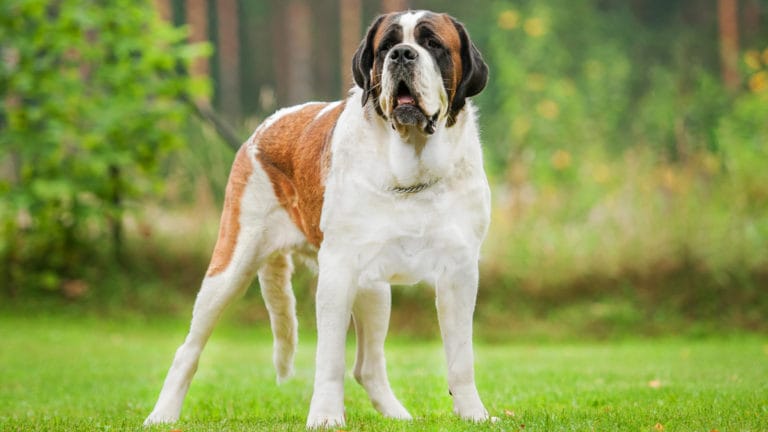It’s no surprise that DNA can play a significant role in dog diseases. After all, DNA impacts everything from a dog’s physical traits to the predisposition to develop a wide variety of dog diseases over his lifetime.
Before we list some of the common genetic diseases in dogs, we must reluctantly admit that many of these conditions are associated primarily with purebred dogs and that mixed breed dogs are more resistant when it comes to congenital dog diseases. DNA tests such as the Wisdom Panel breed and health identification dog DNA test kit or the Embark breed and ancestry identification, trait and health detection dog DNA test kit can help identify health conditions that your dog may be predisposed to along with his breed to better understand what he may be at risk for.
Thousands of years ago most dogs resembled today’s wild dogs such as dingoes or coyotes; they were slight in frame (up to 50 pounds) with long faces, long snouts, long legs and a brown coat. Within the last 250 years, as purebred dogs have gained popularity, they resemble this prototype less and less, and the more radically we change them, the greater the adverse effects.
Read on to find out what some of the most common genetic diseases in dogs are, how you can identify them and how you can attempt to mitigate their effects.
1. Hip Dysplasia
While hip dysplasia is commonly known to affect German Shepherds and related dog breeds, many other large dog breeds are at high-risk, like Saint Bernards (having almost a 50 percent incidence). This is because today’s large and giant breeds grow faster and put on muscle mass that outpaces the concurrent growth of their skeleton. The imbalance of their growth changes the weight distribution on the hip joint and alters the formation of the bones around the hip joint.
Unfortunately, indiscriminate breeding of dogs has made this a permanent affliction for many large breed dogs who develop severe arthritis of the hip joints as time goes by. Poor quality breeding stock has also made this a common finding in a number of smaller breeds as well.
Not all large breed dogs get hip dysplasia. There are reputable breeders that have their breeding stock breeding dogs and studs radiographically evaluated by the experts at the Orthopedic Foundation for Animals (OFA) who provide certified reports on the absence or severity of hip changes. If you are interested in purchasing a large breed puppy and wish to better ensure the chance that hip dysplasia and subsequent osteoarthritis will not cripple your dog in the future, seek out a reputable breeder and ask to see the OFA reports on the parents.
If you are able to identify hip dysplasia early, there are hip surgeries that can restore the normal angle of the hip and mitigate the effects of hip dysplasia. Unfortunately, most cases of hip dysplasia in dogs are diagnosed too late for this type of surgery (and it is expensive), which makes medical management or salvage surgeries for crippled animals the only options available. For affected animals, weight management (staying on the slim side) will also help.
2. Brachycephalic Syndrome
The “brachycephalic syndrome” is a congenital respiratory malformation seen in dogs with rounded heads and compressed faces, classically English Bulldogs, French Bulldogs, Pugs, Boston Terriers and related breeds.
By compressing their skulls over years of selective breeding, we have also incorporated significant abnormalities to their respiratory system. Affected animals have shallow deformed tracheas, slit-like nostrils and other defects that significantly impair their ability to breathe to the point where even slight exercise on a hot day may be fatal to these individuals. In times of stress, the trachea may collapse due to their panicked inhalations.
Chronically affected dogs often have a characteristic “honk,” which may precipitate breathing difficulties on its own.
Surgical options are available for some defects, but collapsing tracheas are rarely fixable. Many English Bulldogs require surgery at a young age simply to ensure a proper airway by opening up the nostrils and trimming the palate to help them breathe more easily.
Owners of predisposed breeds should get them checked out at an early age for signs of defects and must also ensure that these animals are not out in extreme temperatures or exercising excessively.
3. Chondrodysplasia
Chondrodysplasia is a long word which describes the short, twisted legs of many long, low breeds including Dachshunds and Bassett Hounds. Their breed “standard” ultimately results in significant abnormalities of the bones and joints of the legs and severe arthritis later in life.
Even worse, the lack of proportional shortening of the length of the back puts abnormal stress on the intervertebral disks, resulting in a high incidence of disk disease. A good outcome for disk disease is arthritis of the back; a bad one is disk rupture and paralysis.
This entire syndrome results from the mutation of the FGF4 gene that has laid the groundwork for the classic “wiener dog” and all of the heartbreak associated with disk problems.
Disk disease is very unpredictable, and there is no sure way to tell which dogs will have back problems later in life. Weight management and preventing jumping and abnormal whole-body movement in older dogs is always prudent.
4. Degenerative Myelopathy
Alas, the poor German Shepherd. As if hip dysplasia wasn’t enough, here is another disease that causes so many Shepherds to go “down in back” later in life.
Degenerative myelopathy is a non-painful disease resulting in degeneration of the nerves of the spinal cord, which causes weakness in the hindlimbs.
This disease is one of a growing number of congenital diseases in dogs for which a blood test can predict those dogs who are clear (no genes from either parent), a carrier (has one gene which may be passed on to offspring), or at risk (has genes from both parents).
You can mitigate your risk by buying your puppy from a reputable breeder and two “clear” parents.
5. Dilated Cardiomyopathy
A number of breeds, including Doberman Pinschers, Boxers, Great Danes, and Irish Setters have a high incidence of cardiomyopathy, which is a disease in dogs that results in weakening of the heart muscle over time.
This is not a disease for which predictive tests are available, so dogs of these breeds should be screened yearly as they enter middle age (the incidence is almost 60 percent in Dobermans). Once again, an ounce of prevention is the rule—buy from a breeder that knows about the condition and can inform you about any history of it in their breeding animals.
These are only a few of many common genetic dog diseases—the list is endless, and the number of breeds is staggering. If you want a purebred dog, do your homework. Research the diseases along with health conditions and treatments of the breed you’re interested in getting and look for a reputable breeder. Don’t be afraid to ask hard questions; breeders like a prospective buyer who knows about the breed, so it’s a win-win for both you and them.
And please, always consider that sweet older mixed breed dog in the shelter—they can offer just as much love as a purebred and may be less likely to develop health issues like these.
Dr. Bruce Williams is 1985 graduate of the University of Georgia. In addition to his day job as a veterinary pathologist of 26 years, he also has written countless articles and book chapters on all facets of diseases of domestic animals and is currently the CEO of the world’s largest non-profit organization dedicated to the advancement of veterinary and comparative pathology, the C.L. Davis and S.W. Thompson Foundation.
Feature image: Chewy Studios
More on Dog Diseases
Share:











